From the Archives, August 2007
This is collection of photos from the Clair Reuter Collection, which provide a window into the H modified classes in the Midwest during the early and mid-fifties.
Many of the images were taken at a SCCA race at the Atterbury Airforce Base near Columbus, Indiana, on May 30th 1954.
After too many tragic accidents killed road racing on public venues, the SCCA turned to major General Curtis LeMay, who was also a sports car fan. In a deal with the SCCA which would in turn provide money for the Airman’s Living Improvement Fund, LeMay allowed the SCCA to run races at the growing number of airbases which were part of the Strategic Air Command (SAC). The first event was held in October 1952, and events were held from coast to coast from 1952 to 1955.
Atterbury was one of these unique events, which provided a safe but boring venue for the SCCA club members. The big guns were there, Jim Kimberly winning the main event with his Ferrari, and there were enough cars entered to allow individual classes for Austin Healeys, Porsches and MGs.
SCCA’s class system changed quite often, but at Atterbury the classes were representative of the mid-fifties; classes were broken down by stock and modified, the modifieds (race cars) being designated with an “M” after the class: B and C modified were for cars over 1500cc, F production was for cars under 1500cc, but F mod was for racecars under 1100cc. Ferraris usually ran in C modified, Cad Allards in B modified.
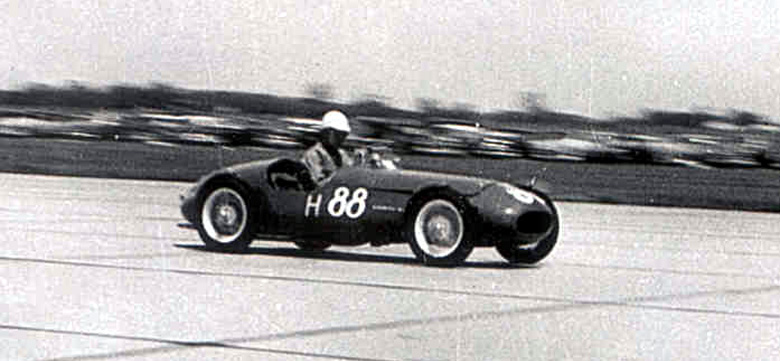
Sandy McArthur, Bandini. Atterbury AFB, May 30th 1954. Sandy later sold this Bandini to Clair Reuter.
In many ways the most interesting, but also the most neglected, was the H modified class, for cars under or about 750cc. By a stroke of luck, the post-war all-American Crosley was powered by a lightweight SOHC engine of just about that capacity, and the factory-built Crosley Hotshot won the first race at Sebring in 1950 (on handicap). The Hotshots were rare, but more abundant were the very fragile Italian 750cc race cars with engines built in small far away garages and very, very hard to come by. Installing the readily available Crosley engine gave these tiny Italians a new lease on life and they quickly populated the H modified grids of SCCA events from coast to coast. In fact the primary importer of the small Italian cars, Tony Pompeo often preferred to receive them from Italy without engines.
At Atterbury, Sandy MacArthur was there with his Bandini, which he later sold to Clair Reuter. The class had six finishers and included one Bandini, four Siatas and a Crosley. Amazingly, these cars raced flat out for 74 miles on a concrete airport course, surely not the forte of such small displacement cars and there were a large number of broken conrods in the H mod classes.
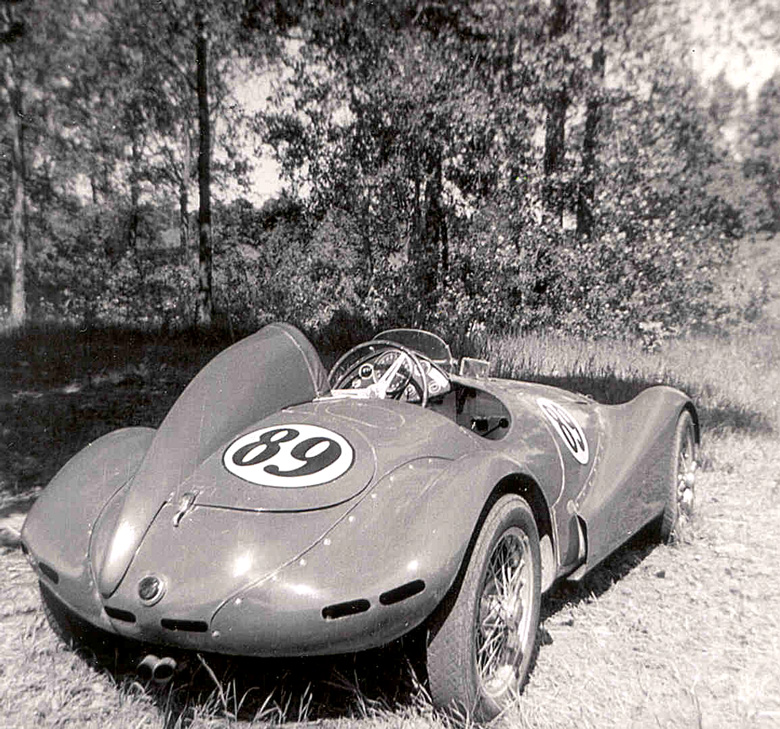
Sandy McArthur’s Giaur. The attractive lines of the car are very evident in this photo taken at Elkhart Lake in 1956.
Cliff Reuter has figured out how many cars Sandy MacArthur raced. A Giaur apparently replaced the Bandini, but not before he ran into the head of Mercury Outboards, Carl Kiekhaefer. MacArthur asked Kiekhaefer if he would sell him a 40 cubic inch outboard to place in MacArthur’s Bandini. According to Jim Jenne, who reported in VeloceToday in The Search for the Sports Stanguellini “This got Kiekhaefer’s attention. During the winter of 1954, Mercury engineers rebuilt the Bandini with their 650cc outboard engine at no charge to MacArthur, who did very well with it the following year with full technical support from Mercury engineers.” According to Mary Kuly’s Uncle Mel Wagner, when Sandy sold the Bandini to Mary’s father Clair, he “kept the Mercury outboard and put it into his new car”. Clair proceeded to equip the Bandini with the good old Crosley engine.
In a letter to Mary Kully, Mel Wagner described the camaraderie of the early sports car racers.
“…it is a broad fraternity made up of people like your dad and our club members to the very wealthy movers and shakers, from brewery magnates, paper product heirs, meat packers fortunes and film stars.
“It was at Milwaukee Wisconsin race where I met (through your dad) Mike Rahal, who raced an Austin Healey. On a later visit with your dad to the Rahal home in either Lombard or Glen Ellen I was introduced to the family and a little kid named Bobby Rahal, who would go on to be a very successful Indy race driver and team owner. Another notable name your dad knew through the Chicago Region of the SCCA was Carl Haas, now half owner of the Newman (as in Paul) Hass Indy racing team. I believe Carl began racing an H mod Stanguellini in 1956, hence the relationship with your father.”
The Giaur is another beautiful car and made a great XMAS card for MacArthur and his family.
Another interesting aspect of these images is that at Wilmot Wisconsin in 1959, Clair Reuter’s Bandini, now sporting a Devin body, is being trailered by the gorgeous Bosley Mk 1 special, a sports car which was conceived by Richard Bosely in the mid fifties.
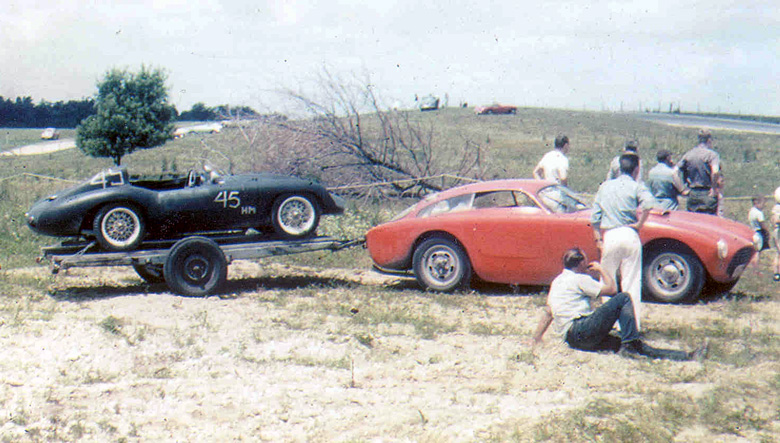
Clair Reuter’s Bandini/Devin trailered by Earl Carlson’s Bosley Mk I at Wilmot, Wisconsin racetrack in 1959. The Bosley was on of the most beautiful American specials of the 1950s, built by Richard Bosley. Carlson is in the white shirt, back to camera, and Bud DuVall is seated on the ground.
Not much can be said about the Siata 750, however. The driver is listed as J.G. Whitlock and the car is almost identical to the Siata which raced in the 1952 Mille Miglia, and preceded the Bertone spider body style so loved by both the Italians and Americans.
Cliff Reuter has been doing a great job of finding and publishing those old SCCA race results, a job the SCCA has so far failed to do. You can find the Atterbury results and many others at www.etceterini.com.
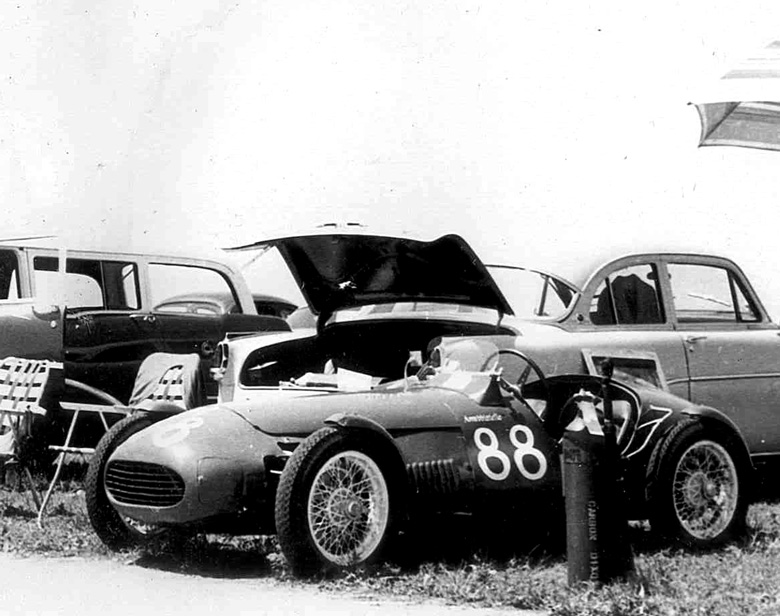

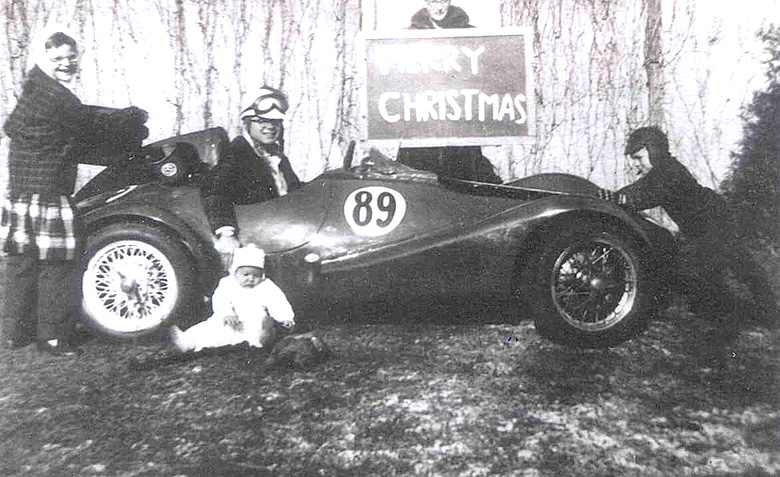
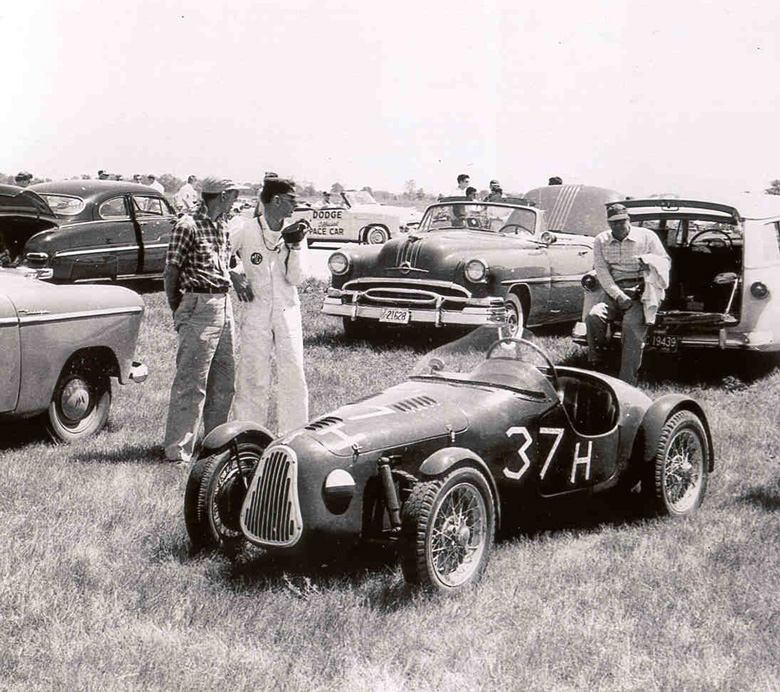
A neat feature story, slightly before my time in the Indy Region of the SCCA.
Camp Atterbury was located near Columbus, IN, not Columbia. There is also an Indiana City named Columbia City located West of Ft, Wayne in the Northern part of the state. During WWII, Atterbury housed Italian POWs.
I remember Sandy McArthur racing #89 at Lawrenceville, IL, also and airport course in June 1960. I captured him on black and white film with a tassel streaming from his helmet.
Charley,
Thanks and I’ll change Columbia to Columbus.
Pete
Pete…the Siata shown, if I am reading Cliff’s information correctly, is a 1948 variant. And as much as I have pored over the MM eligible car list from their site and do see a “siluro” listed as eligible in 1950-52 it is not clear to me what this or any other “<750cc" listed Siata for the early 50s really indicates. SC750 Siluro, 750S, 750 Spider, FIAT 750 Barchetta… dizzing and confusing. Since a number of 300BCs have been accepted and run in the MM Storica I am curious as to any information or pictures about these entries you are willing to share (understandably I think, given a 40 year history with one). What are they and how do they relate to the "Bertone spider body style so loved by both the Italians and Americans."
A Siluro is a Bandini usually with a modified Crosley engine.
Siluro means torpedo and is a description used for many non envelope bodied Italian race cars.
Pete